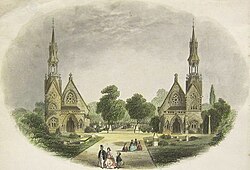| Grove Road Cemetery, Harrogate | |
|---|---|
 Grove Road Cemetery chapels, in 1863 | |
 | |
| Details | |
| Established | 24 April 1864[1] |
| Location | Grove Road, Harrogate |
| Country | England |
| Coordinates | 54°00′01″N 01°32′09″W / 54.00028°N 1.53583°W |
| Type | Public, Anglican, military graves, memorial |
| Owned by | Harrogate Borough Council |
| Website | Grove Road Cemetery |
| Find a Grave | Grove Road Cemetery, Harrogate |
Grove Road Cemetery, Harrogate, North Yorkshire, England, was formerly known as Harrogate Cemetery. It was established in 1864 after the spa town expanded and the graveyard at Christ Church became full. The cemetery once had a pair of chapels with spires, designed by Thomas Charles Sorby. Although they were admired by local residents who felt it enhanced the town view, they were demolished in 1958. However the lodge and gates, also designed by Sorby, remain.
The cemetery contains more than thirty military graves and memorials of those who died in service, including those who did heroic deeds, those who suffered accidents, and those who died of the 1918 influenza, many of them in their twenties or thirties. They include the grave of Sergeant Major Robert Johnston, who took part in the Charge of the Light Brigade. There is also the "Bilton Boys" monument to eleven soldiers from Bilton and High Harrogate, who died in the First World War. There are various elaborate memorials in the cemetery, dedicated to the town's worthies, such as Robert Ackrill, George Dawson, Richard Ellis and David Simpson, who contributed much to the town, besides gravestones of significant local artists, architects and historians. Also of interest are the gravestones of former slave Thomas Rutling and long-distance kayaker Fridel Dalling-Hay.
Grove Road Cemetery has suffered several issues in the past three decades, such as the death of six-year-old Reuben Powell, who was killed by a falling tombstone while playing there. The incident initiated the felling of thousands of cemetery memorials across England, which continued for several years until the panic ceased and councils were advised to use discretion regarding historical monuments and consideration of the bereaved. There has also been an issue of dog-fouling across the graveyard.